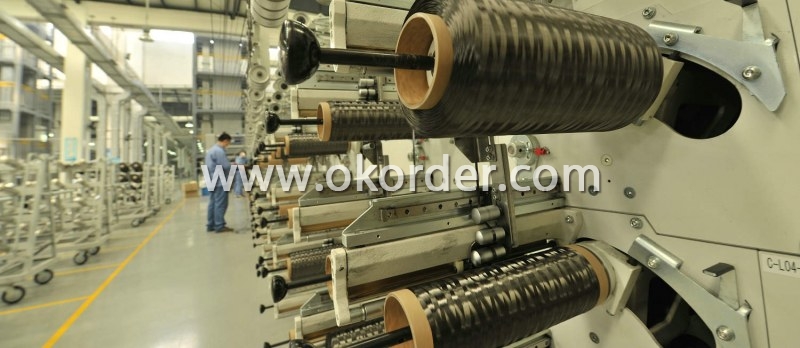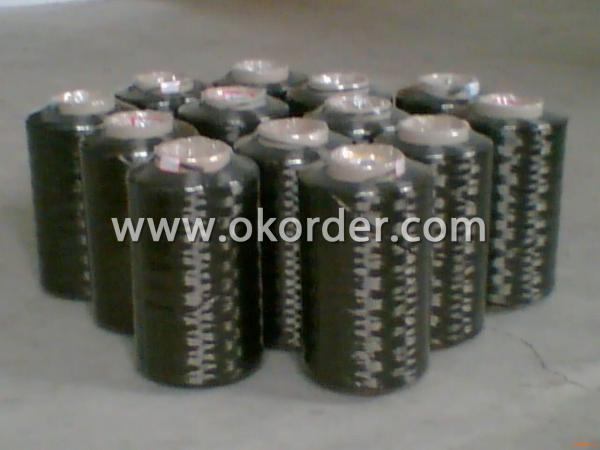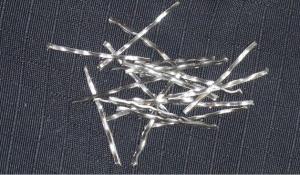Carbon Fiber-6K
- Loading Port:
- China Main Port
- Payment Terms:
- TT or LC
- Min Order Qty:
- 2Ton m.t.
- Supply Capability:
- 1000Ton m.t./month
OKorder Service Pledge
OKorder Financial Service
You Might Also Like
Specifications of Carbon Fiber-6K
1. Material: carbonized polyacrylonitrile fiber
2. Filament number:12k
3. Fiber type: T300
4. Tensile strength: 360kgf/mm2
General Data of Carbon Fiber-6K
Weaving Style: Unidirectional, Plain, Twill
Input Available: 3k, 6k, 12k Carbon fiber
Weight: 15 0 ~ 600g / m2
Roll length: To be specified
Storage of Carbon Fiber-6K
It is recommended that the carbon fiber fabric are stored in a cool and dry environment. Recommended temperature range of storage is between 10 ~ 30 degree and relative humidity between 50 ~ 75%.The carbon fiber fabric should remain in the packaging until just prior to use.
Packaging & Delivery of Carbon Fiber-6K
Product is manufactured in form of a roll wound on a paper tube and then packed in a plastic film and placed within a cardboard carton. Rolls can be loaded into a container directly or on pallets.
Packaging Detail: carton
Delivery Detail: within 20 days


- Q: How is carbon used in the production of ceramics?
- Carbon is used in the production of ceramics as a key component in the creation of carbon-based materials, such as carbon fibers or carbon nanotubes, which can be incorporated into ceramic matrices to enhance their mechanical properties, electrical conductivity, and thermal stability. Additionally, carbon can also be utilized as a reducing agent in certain ceramic processes, such as the production of silicon carbide, where it reacts with oxygen to remove impurities and stabilize the ceramic structure.
- Q: Is carbon a metal or non-metal?
- Carbon is a non-metal. It is located in group 14 of the periodic table, also known as the carbon group. Non-metals generally have properties opposite to those of metals, such as being poor conductors of heat and electricity, having low melting and boiling points, and being brittle. Carbon, specifically, is known for its ability to form a variety of allotropes, including graphite and diamond. These allotropes have different physical and chemical properties, but they all share the characteristic of being non-metals.
- Q: Well, recently, the carbon cycle has suddenly come up with a lot of questions. What's the definition of carbon and light carbon? What are the characteristics, and what are the differences between the two?
- Light and heavy soil organic matter is divided according to the proportion of the isolates used in this study. The proportion of 1.7 is the proportion of < 1.7 for light fraction organic matter, the proportion of > 1.7 recombinant organic matter. The composition and decomposition of organic carbon in different components are significantly different. Light fraction organic matter by no solution complete plant residues and its fractions include a small amount of live microorganisms or their secretions, is susceptible to microbial decomposition and utilization characteristics, is very sensitive to climatic and environmental changes and agricultural management measures, is the active carbon pool in soil.
- Q: Can carbon be recycled?
- Yes, carbon can be recycled.
- Q: What are the properties of activated carbon?
- Activated carbon, also known as activated charcoal, possesses several unique properties that make it highly versatile and useful in various applications. 1. Adsorption: One of the most significant properties of activated carbon is its high adsorptive capacity. It has a vast internal surface area due to its porous structure, which allows it to effectively adsorb molecules, ions, and impurities from gases, liquids, and solids. This adsorption capability makes it ideal for purification purposes, such as water and air filtration, as well as in the removal of toxins and pollutants from industrial processes. 2. Porosity: Activated carbon has a highly porous structure with a network of interconnected pores. This porosity provides a large surface area, enabling it to trap a significant amount of contaminants. The pores can be classified into three types: micropores (less than 2 nm), mesopores (2-50 nm), and macropores (greater than 50 nm), each contributing to its adsorption capacity. 3. Chemical Stability: Activated carbon exhibits excellent chemical stability, making it resistant to degradation and breakdown when exposed to various chemicals or environments. This property allows it to maintain its adsorption capacity over a long period and under harsh conditions, ensuring its efficiency and longevity in different applications. 4. Selectivity: Activated carbon can be tailored to exhibit selectivity towards specific substances by modifying its surface properties. Through various activation processes, such as physical or chemical treatments, the surface chemistry of activated carbon can be altered to enhance its affinity for certain molecules or contaminants, while reducing its affinity for others. This selectivity makes it an effective material for specific applications, such as removing specific pollutants or capturing desired compounds. 5. Regenerability: Another advantageous property of activated carbon is its regenerability. After reaching its adsorption capacity, it can be regenerated by heating or washing with appropriate solvents, allowing it to be reused multiple times before replacement. This regenerability not only reduces the operational costs but also contributes to its sustainability and eco-friendliness. 6. Low Density: Activated carbon has a relatively low density, making it lightweight and easy to handle. This property enables its use in various systems and devices without adding excessive weight or bulk. 7. Thermal Stability: Activated carbon possesses high thermal stability, allowing it to withstand high temperatures without significant degradation. This property makes it suitable for applications involving high-temperature processes, such as gas purification or catalytic reactions. Overall, the properties of activated carbon, including its adsorption capacity, porosity, chemical stability, selectivity, regenerability, low density, and thermal stability, make it a versatile material widely used in water and air purification, gas separation, chemical processing, pharmaceuticals, and many other industries.
- Q: How does carbon affect the formation of cyclones?
- The formation of cyclones is not directly influenced by carbon. Cyclones, also called hurricanes or typhoons, are created through a complex interaction of various factors in the atmosphere and oceans. Carbon, particularly carbon dioxide (CO2), is a greenhouse gas that contributes to global warming and climate change. It is important to emphasize that carbon dioxide concentrations in the atmosphere are increasing due to human activities, such as the burning of fossil fuels. However, this does not directly cause cyclones to form. Nevertheless, climate change resulting from higher levels of carbon dioxide does have an indirect impact on cyclone formation. Climate change leads to warmer temperatures, which in turn increase sea surface temperatures. These elevated temperatures provide the necessary energy for cyclones to form and strengthen. Additionally, higher temperatures cause increased evaporation rates, resulting in more moisture in the atmosphere. This moisture serves as fuel for cyclone development. Furthermore, climate change can modify atmospheric conditions and patterns of circulation. These changes may influence the frequency, intensity, and paths of cyclones. However, the specific effect of carbon dioxide on cyclone formation and behavior remains an active area of research. More studies are required to fully comprehend the relationship between carbon dioxide and cyclones.
- Q: What is carbon neutral manufacturing?
- Manufacturing goods while minimizing or offsetting carbon emissions is what carbon neutral manufacturing is all about. The goal is to reduce greenhouse gas emissions at every stage of the manufacturing process, from obtaining raw materials to disposing of finished products. Achieving this involves various measures, such as improving energy efficiency, utilizing renewable energy sources, implementing sustainable practices, and investing in carbon offset projects. To become carbon neutral, manufacturers typically start by conducting a comprehensive assessment of their carbon footprint. This involves identifying and quantifying all emissions generated in their operations, including both direct emissions from manufacturing processes and indirect emissions from energy sources. Once emissions are measured, manufacturers can devise strategies to decrease their carbon footprint. Common methods for achieving carbon neutrality in manufacturing include optimizing energy consumption through efficient equipment and technologies, adopting renewable energy sources like solar or wind power, and implementing waste reduction and recycling programs. Additionally, manufacturers can invest in carbon offset projects that aim to reduce or eliminate greenhouse gas emissions, such as reforestation or renewable energy initiatives. By implementing these measures and offsetting any remaining emissions, manufacturers can achieve carbon neutrality. This not only helps combat climate change by reducing overall carbon footprints but also demonstrates a commitment to sustainability and environmental responsibility. Carbon neutral manufacturing is an important step towards transitioning to a low-carbon economy and creating a more sustainable future.
- Q: What are some common compounds of carbon?
- Carbon forms a wide range of compounds due to its unique ability to bond with other carbon atoms and a variety of other elements. Some common compounds of carbon include carbon dioxide (CO2), methane (CH4), ethanol (C2H5OH), ethene (C2H4), acetic acid (CH3COOH), and glucose (C6H12O6). These compounds are essential in various fields such as biology, chemistry, and industry. For example, carbon dioxide is a greenhouse gas that plays a crucial role in the Earth's climate system, methane is a potent greenhouse gas released during natural gas production and contributes to climate change, ethanol is a common alcohol used as a fuel and solvent, ethene is used to produce plastics, acetic acid is a key component in vinegar, and glucose is a primary source of energy for living organisms. These compounds highlight the versatility and importance of carbon in the world around us.
- Q: What's the difference between carbon steel pipes and stainless steel pipes and seamless steel tubes?
- As the name implies, carbon steel is made of carbon steel, forming mostly by welding, drawing, rolling, adopted the extrusion molding, and the steel tube drawing, rolling, extrusion molding are called seamless steel pipe welded steel pipe.
- Q: How is carbon used in the production of fuels?
- Carbon is a critical element in the production of fuels, as it is the main component of fossil fuels such as coal, oil, and natural gas. These fuels are formed from the organic remains of plants and animals that lived millions of years ago. The process of carbonization or carbonization involves subjecting these organic materials to high pressure and temperature over a long period, which transforms them into hydrocarbon-rich substances. Coal, for example, is primarily composed of carbon, along with small amounts of other elements. When coal is burned, this carbon reacts with oxygen, releasing energy in the form of heat. This heat can then be utilized to produce steam, which drives turbines to generate electricity or to power engines in various industries. Similarly, oil and natural gas, which are also predominantly composed of carbon, are extracted from underground reservoirs. These hydrocarbons can be processed through refining to produce various types of fuels, such as gasoline, diesel, and jet fuel. The combustion of these fuels in engines or power plants allows for energy release, enabling transportation and the generation of electricity. In addition to fossil fuels, carbon is also used in the production of alternative fuels like biofuels. Biofuels are produced from renewable sources such as plants, algae, or agricultural waste. The carbon contained in these organic materials can be converted into ethanol or biodiesel through processes like fermentation or transesterification, respectively. These biofuels can then be used as substitutes for conventional fossil fuels, reducing greenhouse gas emissions and dependence on non-renewable resources. Overall, carbon is an essential component in the production of fuels, whether derived from fossil fuels or renewable sources. Its combustion releases energy, which is harnessed for various purposes, including electricity generation, transportation, and industrial processes. However, it is important to explore and adopt sustainable alternatives to fossil fuels, such as biofuels and renewable energy sources, to mitigate the negative environmental impacts associated with carbon emissions.
1. Manufacturer Overview
| Location | Jiangsu,China |
| Year Established | 2002 |
| Annual Output Value | |
| Main Markets | Europe, America, Africa, Oceania and Japan, Korea, southeast Asia |
| Company Certifications | ISO9000 |
2. Manufacturer Certificates
| a) Certification Name | |
| Range | |
| Reference | |
| Validity Period |
3. Manufacturer Capability
| a) Trade Capacity | |
| Nearest Port | |
| Export Percentage | |
| No.of Employees in Trade Department | |
| Language Spoken: | |
| b) Factory Information | |
| Factory Size: | |
| No. of Production Lines | |
| Contract Manufacturing | |
| Product Price Range | |
Send your message to us
Carbon Fiber-6K
- Loading Port:
- China Main Port
- Payment Terms:
- TT or LC
- Min Order Qty:
- 2Ton m.t.
- Supply Capability:
- 1000Ton m.t./month
OKorder Service Pledge
OKorder Financial Service
Similar products
Hot products
Hot Searches
Related keywords



























